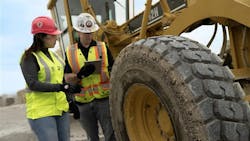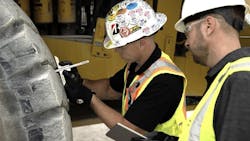Tire Safety on Construction Equipment
Key Highlights
In this article, you will learn:
- How regular tire inspection can identify potential hazards early.
- How to use tire pressure monitoring systems (TPMS).
- Why and when tire-inflation cages are required.
- How detailed records inform replacement schedules.
- Where to find training for technicians.
At least eight fatalities were reported in 2023 from OTR tire servicing activities in the U.S. And safety professional estimate that for every tire-related fatality there may be 20 or more near-miss or nonfatal injuries.
Most of these accidents were either tires falling off jacks or tires exploding due to over-inflation. Injuries to the head were the most common cause of death.
Differences with Large and Small Machines
Significant differences exist in the safe use and maintenance of tires for compact machines and larger earthmovers, says Bill Holton, Kubota Tractor.
- Compact machines operate at lower loads and tire pressures. Tire failure affects productivity, but tires can be more easily repaired or replaced, and downtime is manageable. They are often used in urban or confined spaces with mixed terrain where the tires need to handle frequent turning, curbs, and debris.
- Large earthmovers carry extremely heavy loads, requiring high-pressure tires. Here blowouts and failure can be costly and dangerous. Applications often call for tires with deep treads and cut-resistant compounds. Big tires can cost tens of thousands of dollars, and unplanned downtime can lead to significant financial loss. With these types of machines, tire replacement and repair should be done by trained personnel with the proper equipment and safety protocols.
Preventing fatalities and injuries should be of primary concern. But a tire blowout on any machine can create costly disruptions and delays in the production schedule of an owner-operator landscaping company, civil earthmoving enterprise, or a big mine or quarry operation.
Maximizing tire safety, uptime, and ROI is neither complex nor difficult. Set up a tire safety program, train everyone in the shop and the field—and stick to it.
Safe use of construction tires
Read the manual. Amateurs like to joke that they never read manuals or instructions. Pros read every word. The manual will specify what types of tires to use, the recommended air pressure, and additional information to help maintain tires and wheels, says Bill Holton, product manager, compact construction equipment for Kubota Tractor.
The tire manual will also confirm that the tires are rated for the load and terrain, Holton says. Check the DOT code or the date of manufacture and replace tires that are past the OEM’s recommended date—even if the tread looks fine.
Inspections. Before the start of any shift, operators should examine the tires and look for blemishes and cuts on the tire’s exterior, says Grok Gates, OTR director of business development at Bridgestone Americas. Look for the following problem areas:
- Check air pressure when the tires are cold and adjust if necessary. Remember that even a slight cut in a tire inflated to 90 or 100 psi can balloon dangerously or explode at any time without warning.
- Look for visible damage: cuts cracks punctures, bulges, bubbles, and sidewall damage.
- Note any uneven wear on the tread, cupping, scalloping, or bald spots. This may signal alignment or suspension issues or negligent operation that need to be addressed.
- Inspect rims for cracks, bends, or corrosion. Ensure that valve stems are intact and that the valve stem caps are in place.
- Assess the site. Before and during construction, closely inspect job sites for debris, roots, rebar, or potential hazards. And remember that wet ground conditions greatly increase the likelihood of cuts.
Measure and record tread depth. This will provide an approximate wear rate allow latitude for scheduling tire replacement downtime. Once the minimum tread depth is reached, traction will be greatly compromised and lead to poor performance and the heightened risk of a blowout. Over time, good record keeping will enable informed choices of the best tires for performance and longevity in different jobs and conditions.
Leverage technology. Tire pressure monitoring systems (TPMS) and tire temperature sensors provide real-time information on the two most critical factors governing tires. This information is important because the extreme weights and loads carried by OTR tires can ramp up pressures and temperatures to a much greater degree than is common on automotive and truck tires.
All major tire OEMs offer these from the factory, and retrofit TPMS and temperature sensors allow for better monitoring of existing or older tires.
Keep score. Given the cost of tires, it can be well worth the time to keep performance records of each tire in the fleet to maximize performance and minimize costs. Having historical data enables better understanding of how tire and machine are performing at the job site. The insights from this data allow for operational adjustments and can boost productivity and safety, says Gates.
“We recommend customers consider tire monitoring and asset management-based platforms, no matter the size of the job site,” he says.
Tire cages protect technicians
Exploding tires from over-inflation or weak spots in the tread or sidewalls prompted OSHA to require the use of tire inflation cages in workplaces when servicing multi-piece and single-piece rim wheels on trucks, tractors, trailers, buses, and some off-road equipment. The regulation was adopted in 1987 as OSHA standard 29 CFR 1910.177. and has been amended several times since.
Inflation cages run in sizes from pickup truck tires to the biggest mining trucks and can be obtained from companies such as Martins Industries (martinsindustries.com), Ken-Tool (kentool.com), Branick Industries (tiresupplynetwork.com), and Ranger Products (bendpak.com).
Although tires may not receive the attention that engines and hydraulics do, their selection, service, and maintenance is every bit as complex. Tires alone are highly engineered products. Rims, valves, inflation/deflation, installation and removal systems, and tools are also technical. Fortunately, there is a wealth of resources and training available through the Tire Industry Association.
The TIA’s Basic 200 Level Basic Earthmover Tire Service (ETS) course is designed for new hires and can be used for experienced techs for certification purposes. The course can be completed online or in person. Additional 200 level courses include instruction on automotive, commercial, farm and industrial tires.
The Certified 300/400 Level Technician Certified Earthmover Tire Service course is designed for OTR technicians with several years of hands-on experience. The courses are taught by a TIA 400 Level Instructor and recertification is required every two years via an online exam.
How TMPH affects tire safety
The topographical design of many mining and quarry sites is often dictated by how much stress and heat the tires on large wheel loaders and haul trucks can withstand.
These site designs are based on an engineering formula called tons miles per hour or TMPH (TMPK for kilometers) that factors in distances traveled, weights/loads carried, and vehicle speed. Excessive distances, speeds, and heavier loads all increase heat in the tire and risk damage or blowouts.
To maximize speed, reduce the loads carried or distances the machines travel. To optimize loads carried, adjust the truck speed or distance. Haul road gradient is also taken into consideration as steep inclines put additional stress on the tires.
TMPH may not be relevant for landscaping jobs or a small-to-medium size construction site. But knowing how load, speed, and distance affect tire life, safety, and performance can give any contractor a better appreciation for these expensive assets under their machines.
About the Author


